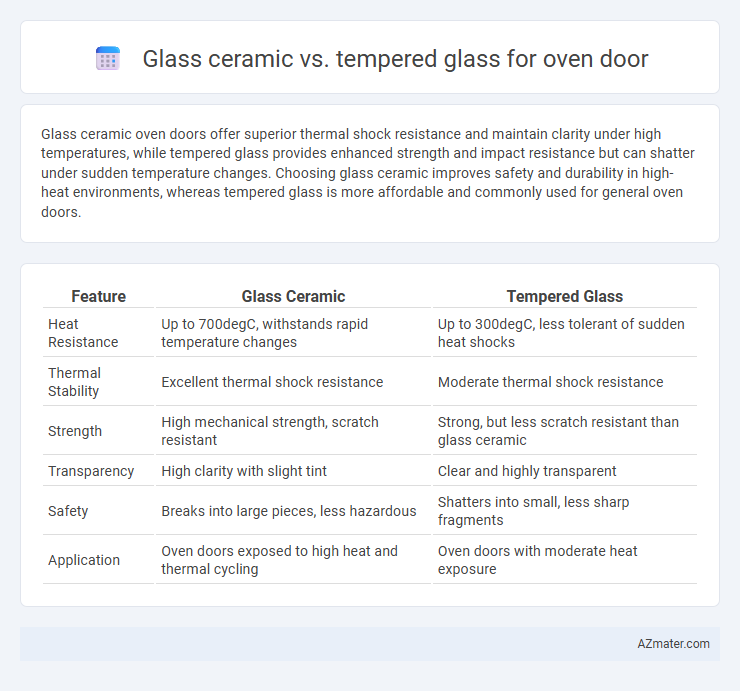Glass ceramic oven doors offer superior thermal shock resistance and maintain clarity under high temperatures, while tempered glass provides enhanced strength and impact resistance but can shatter under sudden temperature changes. Choosing glass ceramic improves safety and durability in high-heat environments, whereas tempered glass is more affordable and commonly used for general oven doors.
Table of Comparison
| Feature | Glass Ceramic | Tempered Glass |
|---|---|---|
| Heat Resistance | Up to 700degC, withstands rapid temperature changes | Up to 300degC, less tolerant of sudden heat shocks |
| Thermal Stability | Excellent thermal shock resistance | Moderate thermal shock resistance |
| Strength | High mechanical strength, scratch resistant | Strong, but less scratch resistant than glass ceramic |
| Transparency | High clarity with slight tint | Clear and highly transparent |
| Safety | Breaks into large pieces, less hazardous | Shatters into small, less sharp fragments |
| Application | Oven doors exposed to high heat and thermal cycling | Oven doors with moderate heat exposure |
Introduction to Oven Door Materials
Oven doors commonly use glass ceramic and tempered glass, each offering distinct thermal properties and durability. Glass ceramic withstands rapid temperature changes up to 750degC, making it ideal for high-heat cooking, while tempered glass provides enhanced strength and shatter resistance with a maximum heat tolerance around 290degC. Selecting the right material impacts heat retention, safety, and overall oven efficiency.
Understanding Glass Ceramic
Glass ceramic used for oven doors offers exceptional thermal shock resistance and can withstand rapid temperature changes up to 700degC without cracking, making it ideal for high-heat cooking environments. Unlike tempered glass, which is heat-strengthened and designed primarily for safety by breaking into small, less dangerous pieces, glass ceramic maintains structural integrity under intense heat and thermal cycling. This unique material combines crystalline and glassy phases, providing both mechanical strength and heat resistance critical for oven door applications.
What Is Tempered Glass?
Tempered glass is a type of safety glass processed by controlled thermal or chemical treatments to increase its strength compared to normal glass. It is designed to withstand high temperatures and thermal stress, making it suitable for oven doors where heat resistance and safety are critical. In contrast, glass ceramic offers superior thermal shock resistance and can handle rapid temperature changes without cracking, but tempered glass remains a more affordable and commonly used option in oven door construction.
Thermal Resistance Comparison
Glass ceramic oven doors exhibit superior thermal resistance compared to tempered glass, withstanding temperatures up to 750degC without deformation or cracking. Tempered glass typically resists heat up to approximately 300degC but is prone to thermal shock under sudden temperature changes. The higher thermal stability of glass ceramic enhances durability and safety in high-temperature oven applications.
Heat Distribution and Efficiency
Glass ceramic oven doors offer superior heat distribution due to their low thermal conductivity, which allows even heat diffusion and minimizes hot spots during cooking. Tempered glass, while stronger and more resistant to impact, has higher thermal conductivity, leading to less uniform heat distribution and potential energy inefficiency. Choosing glass ceramic enhances oven efficiency by maintaining stable internal temperatures and reducing heat loss compared to tempered glass.
Durability and Impact Resistance
Glass ceramic oven doors offer superior durability and impact resistance due to their ability to withstand rapid temperature changes without cracking, making them ideal for high-heat environments. Tempered glass, while stronger than regular glass and more resistant to impact, is more prone to thermal shock and can shatter under sudden temperature fluctuations. The manufacturing process of glass ceramic involves controlled crystallization, enhancing its mechanical strength and thermal stability compared to the heat-treated tempering process used for tempered glass.
Safety Features and Shatter Behavior
Glass ceramic oven doors offer superior heat resistance and maintain structural integrity at temperatures up to 700degC, reducing the risk of sudden breakage during cooking. Tempered glass, while toughened to withstand thermal stress and impact, breaks into small, blunt fragments rather than sharp shards, enhancing user safety in case of shattering. The shatter behavior of glass ceramic involves cracking without complete fragmentation, while tempered glass disperses energy by crumbling safely, making tempered glass preferable for preventing injury upon breakage.
Maintenance and Cleaning Ease
Glass ceramic oven doors resist scratches and thermal shock, making them easier to maintain and clean compared to tempered glass. Their smooth, non-porous surface prevents grease and grime buildup, simplifying routine wiping. Tempered glass requires cautious cleaning to avoid damage from abrasive materials or sudden temperature changes, increasing maintenance effort.
Cost Analysis: Glass Ceramic vs Tempered Glass
Glass ceramic oven doors generally cost more upfront due to their superior heat resistance and durability, allowing higher temperature tolerance without deformation. Tempered glass is less expensive initially but may require more frequent replacement due to lower thermal shock resistance, impacting long-term costs. When evaluating total cost of ownership, glass ceramic offers better value by minimizing maintenance and replacement expenses over the oven's lifespan.
Best Choice for Your Oven Door
Glass ceramic offers superior heat resistance and thermal shock durability, making it ideal for oven doors exposed to rapid temperature changes. Tempered glass provides enhanced strength and safety by shattering into small, less harmful pieces, but it lacks the same thermal stability as glass ceramic. For optimal performance and longevity in oven doors, glass ceramic is the best choice due to its ability to withstand extreme heat while maintaining structural integrity.

Infographic: Glass ceramic vs Tempered glass for Oven door
 azmater.com
azmater.com